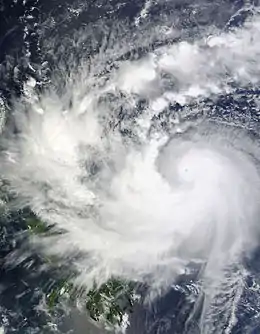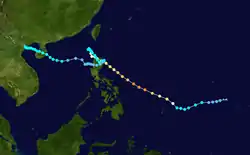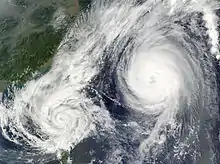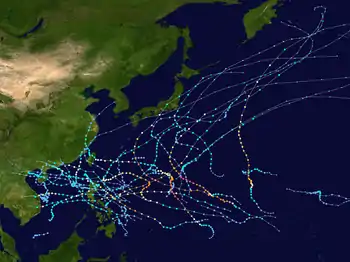Typhoon Parma
Typhoon Parma, known in the Philippines as Typhoon Pepeng, was the second typhoon to affect the Philippines within the span of a week during September 2009.
| Typhoon (JMA scale) | |
|---|---|
| Category 4 super typhoon (SSHWS) | |
 Typhoon Parma at peak intensity on October 1 | |
| Formed | September 27, 2009 |
| Dissipated | October 14, 2009 |
| Highest winds | 10-minute sustained: 185 km/h (115 mph) 1-minute sustained: 250 km/h (155 mph) |
| Lowest pressure | 930 hPa (mbar); 27.46 inHg |
| Fatalities | 500 total |
| Damage | $617 million (2009 USD) |
| Areas affected | Caroline Islands, Philippines, Taiwan, China and Vietnam |
| Part of the 2009 Pacific typhoon season | |
Typhoon Parma was assigned the name Pepeng by PAGASA when it entered the Philippine Area of Responsibility days after Typhoon Ketsana wreaked havoc on the country. Parma spared the capital and instead lashed the northern part of Luzon island.
Parma added to the damage caused by the earlier Typhoon Ketsana, affecting thousands of families on the north, especially on Pangasinan province where the San Roque Dam inadvertently released water to prevent its breach. However, in the first week of October, Parma interacted with the incoming Typhoon Melor on the Pacific (via a Fujiwhara interaction), rendering it stationary as it made landfall on Southern Taiwan. Days later, the greatly weakened Parma retreated back to Luzon making further landfalls on Ilocos Norte and Cagayan. The now severe tropical storm Parma then began to wane its strength as it crossed Luzon island for the second time. It then emerged on the South China Sea as a tropical depression. Parma became one of the deadliest typhoons to hit the Philippines in a decade.
Meteorological history

During September 26, the Joint Typhoon Warning Center (JTWC) started to monitor an area of convection that was located about 445 km (275 mi), to the southeast of Guam.[1] The system had an elongated low-level circulation center with convection developing around the center.[1] Upper level analysis showed that the system was located in an area of low vertical wind shear and had a good poleward outflow into a tropical upper tropospheric trough.[1] During the next day, convection started to consolidate before both the Japan Meteorological Agency (JMA) and the JTWC initiated advisories on the system, with the JTWC designating it as Tropical Depression 19W. After being classified, the depression remained weak and poorly organized, as it lay close to Tropical Storm 18W. During September 28, as the depression moved away from 18W, the JTWC reported that the depression had intensified into a tropical storm despite it remaining poorly organized, and acquired the name Parma.
Parma started to intensify to a typhoon as it moved closer to the Philippines. On October 1, Parma reached its peak intensity with winds of 250 km/h (155 mph). Afterwards, Parma started a weakening trend as it moved closer to the Philippines, and on October 3 made landfall northern luzon, Philippines.[2][3] During its landfall in the Philippines, Parma began to travel northwest towards China. It slowed down and weakened (due to interactions with Typhoon Melor), then turned back south towards the Philippines. Parma made a second landfall on October 6 with sustained winds of 105 kilometres per hour (65 mph).[2] It weakened to a tropical depression before emerging off the east coast of Luzon on October 7, remaining stationary for a day. On October 8 it made a third landfall the eastern coast of Cagayan, then moved slowly across Luzon, eventually emerging in the South China Sea.[2] After regaining some strength, it travelled westward and hit the island of Hainan, China, with winds of 39 miles per hour (63 km/h).[4] It then made a final landfall in Vietnam on October 13, and dissipated over the country on October 14.[4]
Preparations
Caroline Islands
| Hurricane warning levels |
|---|
| Hurricane Warning |
|
Hurricane conditions expected within 36 hours. |
| Hurricane Watch |
|
Hurricane conditions possible within 48 hours. |
| Tropical Storm Warning |
| Tropical storm conditions expected within 36 hours. |
| Tropical Storm Watch |
| Tropical storm conditions possible within 48 hours. |
| Storm Surge Warning |
| Life-threatening storm surge possible within 36 hours. |
| Storm Surge Watch |
| Life-threatening storm surge possible within 48 hours. |
| Extreme Wind Warning |
| Winds reaching Category 3 status or higher likely (issued two hours or less before onset of extreme winds). |
Early on September 28, the National Weather Service Weather Forecast Office in Guam using data from the Joint Typhoon Warning Center placed Ulithi, Faraulep and Fais under tropical storm warnings and declared Tropical storm watches for Yap and Ngulu whilst the depression was moving towards the state of Yap.[5] Tropical storm warnings were then declared for Yap and Ngulu later that morning as the depression was moving to the northwest of Faraulep.[6] These warnings stayed in effect until early the next day when they canceled the warnings for Faraulep, Fais and Ulithi after the depression had intensified into a named storm, and had passed by the islands.[7][8][9] NWS Guam then placed Koror and Kayangel under a tropical storm watch later that day before cancelling all warnings early on September 30.[10][11]
Philippines
| Rank | Storm | Season | Damage | Ref. | |
|---|---|---|---|---|---|
| PHP | USD | ||||
| 1 | Yolanda (Haiyan) | 2013 | ₱95.5 billion | $2.2 billion | [12] |
| 2 | Pablo (Bopha) | 2012 | ₱43.2 billion | $1.06 billion | [13] |
| 3 | Glenda (Rammasun) | 2014 | ₱38.6 billion | $885 million | [14] |
| 4 | Ompong (Mangkhut) | 2018 | ₱33.9 billion | $627 million | [15] |
| 5 | Pepeng (Parma) | 2009 | ₱27.3 billion | $581 million | [16] |
| 6 | Ulysses (Vamco) | 2020 | ₱20.3 billion | $421 million | [17] |
| 7 | Rolly (Goni) | 2020 | ₱20 billion | $369 million | [18] |
| 8 | Pedring (Nesat) | 2011 | ₱15.6 billion | $356 million | [13] |
| 9 | Lando (Koppu) | 2015 | ₱14.4 billion | $313 million | [19] |
| 10 | Frank (Fengshen) | 2008 | ₱13.5 billion | $304 million | [20] |
The National Disaster Coordinating Council (NDCC) advised all local government officials across Luzon to evacuate people if needed to ensure their safety. In addition to the NDCC, they gave out relief goods and other necessities. President Gloria Macapagal Arroyo also requested PAGASA to monitor the super typhoon every two hours and update its website.[21] Also, the Philippine Atmospheric, Geophysical and Astronomical Services Administration (PAGASA) advised all areas with public storm signals to be alerted against storm surges, landslides, and flash floods. The Coast Guard placed the entire country under red alert, meaning that the agency would monitor the whole country, especially Northern and Central Luzon. All ferry stations with routes from Luzon to Visayas and vice versa suspended operations, and fishermen were advised not to go to sea to avoid turbulent waves.[22]
As preparations continued, different dams were opened and large amounts of water freed to avoid the overflowing of dams. In Isabela, the Magat Dam released a large amount of water. Its water was projected to pass through Cagayan River, forcing locals along the river to evacuate. The Angat Dam in Bulacan also released large amounts of water, flooding the towns of Calumpit and Hagonoy. Local officials took evacuated people living in the area. Five barangays in Nueva Ecija were already flooded due to water from Pantabangan Dam, which released 250 cubic meters per second from 1 pm on October 1, 05:00 (UTC) to 1 am on October 2, 17:00 (UTC). Local officials also took charge to evacuate people. In Laguna, the Caliraya Dam released water as a precaution against Parma's heavy rains, even though Laguna would not be directly affected by the super typhoon.[23] On the morning of October 2, President Gloria Macapagal — Arroyo declared the whole country under a state of calamity.
In Metro Manila, billboards were rolled down due to strong winds that were anticipated. Air travel, cargo ships, and other water transport throughout the Islands were suspended.[24] The Commission on Higher Education (CHED) suspended classes for regions 1, 2, 3, 4a, 4b, 5 and CAR.[25] In Laguna, the Laguna Lake Development Authority (LLDA) evacuated a massive 100,000 residents that live near the Laguna lake.[26]
Taiwan
Following the devastating impacts of Typhoon Morakot in August, residents in southern Taiwan were weary upon hearing of a new typhoon approaching the region. By October 3, residents of six villages in the hard hit county of Kaohsiung began evacuating.[27] The following day, the Central Weather Bureau issued a land warning for the Hengchun Peninsula as Parma moved over the northern Philippines. Residents in the region were advised to prepare for heavy rains and high winds in relation to the storm.[28] At least 55 international flights from Taiwanese airports were cancelled or delayed due to Typhoon Parma as it stalled in the Bashih Channel.[29] On October 5, mandatory evacuations were put in place for portions of southern Taiwan, leading to roughly 6,000 residents leaving the area for shelter. Emergency officials deployed 200 elite soldiers to the region to assist in the evacuation and placed 35,000 more on standby for relief operations.[30]
Impact
Caroline Islands
While it was a Tropical Storm, Parma passed to the south of the westernmost state of Yap, battering the east coast of the main island with torrential rain and winds of up to 95 km/h (60 mph). As a result, Continental Micronesia cancelled its scheduled passenger flight to Guam, while the governor of Yap ordered that government employees stay at home and that residents take all precautions that were possible while placing Yap under the highest state of storm alerts.[33][34][35]
Philippines

Even though Parma was still too far to make its landfall in northern Philippines, various transportation was suspended before the super typhoon draw near. In Catanduanes, where the first signal warning no.3 was raised, the province's power and communications were cut. Fallen trees were already in the main roads. About 30,000 families were evacuated. In addition also to the Bicol region, more than 2,000 passengers were stranded in ferry stations.[36] 39 provinces including Metro Manila were put to signal warnings, with each place experienced massive rainfall with strong winds. Parma made its landfall at Northeastern Cagayan at 3:00pm PST/07:00 (UTC). In Cagayan, at least 6,036 people in 39 barangays (villages) were affected, while P20.33 million worth of agricultural produce were destroyed. Also, in the Chico River was swelled due to the typhoon, making the Maguilling Overflow Bridge along the Cagayan–Apayao Road impassable. The Maharlika Highway in Ilagan, Isabela to Cagayan became hardly passable due to the trees and electric posts that fell when Pepeng battered the area. Total power interruption also crippled the provinces of Kalinga, Apayao, and the northern towns of Isabela. In Kalinga, landslides were reported on roads linking the provincial capital, Tabuk, to upland towns. In Zambales, at least 2,100 families were evacuated as Pepeng brought heavy rains causing the Bucao River to swell. The Carael section of the Zambales highway became impassable due to rising floodwaters.[37] Due to heavy downpour, the San Roque Dam in Eastern Pangasinan and Pantabangan Dam in Nueva Ecija was forced to release huge amount of water. It caused major flooding in Tarlac which is their neighbouring province and also caused flooding Eastern and Central Pangasinan as well as Nueva Ecija. In Metro Manila the area is still experienced torrential rains and strong winds. Floodwaters continue to rise in some areas in Metro Manila and Calabarzon. In Pateros, Muntinlupa, and Taguig, in Taytay town in Rizal province, and in the towns of Biñan and San Pedro in Laguna province, the flood is not subsiding. The Laguna de Bay is breaking a 90-year record in meters of water, which threatens to submerge more areas in Metro Manila.[38] In Benguet, a landslide killed at least 200 as Tropical Depression Parma continues to bring rain across northern Luzon.[39] Due to severe flooding, Leptospirosis became a problem that affected many. In Pasig City General Hospital alone, 30 people have been taken in for diagnosis. The Department of Health announced that there is a Leptospirosis outbreak in Marikina.
Taiwan
Torrential rainfall fell across southern Taiwan as Typhoon Parma stalled south of the island. In some areas, more than 500 mm (20 in) of rain fell, resulting in floods up to .5 m (1.6 ft) deep. These floods prompted emergency evacuations in hundreds of villages throughout Taiwan. After 200 mm (7.9 in) of rain fell in Yilan County, emergency officials enacted the first mandatory evacuation in northern Taiwan, relocating hundreds of residents. Several landslides were reported in mountainous regions, mainly in southern parts of the island. Military convoys loaded with sandbags traveled to rising rivers to help reinforce them and prevent them from overflowing their banks. As a result of the continuous rainfall and cloud cover, temperatures across Taiwan fell below average.[40]
Off the coast of Taiwan, a ship carrying 14 people sank after being battered by rough seas produced by Typhoon Parma. One person was confirmed dead, three were rescued and ten others were listed as missing.[41]
China
Off the cost of Hainan Island, a ship carrying nine people capsized. Three people were confirmed to have drowned, five were rescued and one other remains missing.[42]
Vietnam
Typhoon Parma made its final landfall near Hai Phong on October 15 after causing damage to Bach Long Vi island where 62 fishing boats were sunk. No deaths were reported.[43]
Retirement
Due to the large number of fatalities and damage caused by the storm, the names Parma and Pepeng were later retired. The committee selected the name In-fa to replace "Parma" on the Western Pacific basin name lists beginning in 2011. For the PAGASA, on 2012, the name chosen to replace "Pepeng" was Paolo for the 2013 season.
See also
- Effects of the 2009 Pacific typhoon season in the Philippines
- List of wettest tropical cyclones
- Typhoons in the Philippines
- Timeline of the 2009 Pacific typhoon season
- Tropical Storm Thelma (Uring, 1991) – second deadliest tropical cyclone to strike the Philippines
- Tropical Depression Winnie, 2004
- Typhoon Durian (Reming, 2006)
- Typhoon Xangsane (Milenyo, 2006)
- Typhoon Ketsana (Ondoy, 2009) – a typhoon that hit Central Luzon just one week before Parma
- Typhoon Megi (Juan, 2010)
- Tropical Storm Washi (Sendong, 2011)
- Typhoon Son-Tinh (Ofel, 2012)
- Typhoon Bopha (Pablo, 2012)
- Typhoon Usagi (Odette, 2013)
- Typhoon Krosa (Vinta, 2013)
- Typhoon Haiyan (Yolanda, 2013) – deadliest tropical cyclone to strike the Philippines in the 21st Century
- Typhoon Vongfong (Ambo, 2020)
- Typhoon Goni (Rolly, 2020)
References
- "Significant Tropical Weather Advisory for the Western and Southern Pacific Oceans 2009-09-27 06z". Joint Typhoon Warning Center. 2009-09-27. Retrieved 2009-10-01.
- Glenn J Rabonza. FINAL Report on Tropical Storm "ONDOY" {Ketsana} and Typhoon "PEPENG" {Parma} (PDF). Quezon City, Philippines: National Disaster Coordinating Council. Archived from the original (PDF) on 2017-01-19. Retrieved 2018-07-02.
- Communicable Diseases Working Group on Emergencies (2009). Tropical Storm Ketsana and Typhoon Parma, the Philippines (PDF). Geneva, Switzerland: World Health Organization. Retrieved 2018-07-02.
- Rob Gutro (2009-10-14). "Hurricane Season 2009: Tropical Storm Parma (Western Pacific)" (Press release). Goddard Space Flight Center. NASA. Retrieved 2018-07-02.
- Roger Edson; Derek Williams; Patrick Chan (2009-09-28). "NWS Guam Tropical Depression 19W Advisory 1". National Weather Service Weather Forecast Office in Guam. National Oceanic and Atmospheric Administration. Archived from the original on 2009-10-02. Retrieved 2009-10-01.
- Paul Lee (2009-09-28). "NWS Guam Tropical Depression 19W Advisory 3". National Weather Service Weather Forecast Office in Guam. National Oceanic and Atmospheric Administration. Archived from the original on September 28, 2009. Retrieved 2009-10-01.CS1 maint: unfit URL (link)
- Roger Edson, Derek Williams, Mcelroy (2009-09-28). "NWS Guam Tropical Depression 19W Advisory 5". National Weather Service Weather Forecast Office in Guam. National Oceanic and Atmospheric Administration. Archived from the original on September 28, 2009. Retrieved 2009-10-01.CS1 maint: multiple names: authors list (link) CS1 maint: unfit URL (link)
- Derek Williams, Roger Edson, Mcelroy (2009-09-28). "NWS Guam Tropical Storm Parma (19W) Advisory 5A". National Weather Service Weather Forecast Office in Guam. National Oceanic and Atmospheric Administration. Archived from the original on 2009-10-02. Retrieved 2009-10-01.CS1 maint: multiple names: authors list (link)
- Derek Williams; Charles Guard (2009-09-28). "NWS Guam Tropical Storm Parma (19W) Advisory 6". National Weather Service Weather Forecast Office in Guam. National Oceanic and Atmospheric Administration. Archived from the original on September 29, 2009. Retrieved 2009-10-01.CS1 maint: unfit URL (link)
- Dan Mundell (2009-09-29). "NWS Guam Typhoon 19W (Parma) Advisory 8". National Weather Service Weather Forecast Office in Guam. National Oceanic and Atmospheric Administration. Archived from the original on 2009-10-02. Retrieved 2009-10-01.
- Roger Edson; Derek Williams (2009-09-30). "NWS Guam Typhoon 19W (Parma) Advisory 10". National Weather Service Weather Forecast Office in Guam. National Oceanic and Atmospheric Administration. Archived from the original on September 30, 2009. Retrieved 2009-10-01.CS1 maint: unfit URL (link)
- del Rosario, Eduardo D. (April 2014). FINAL REPORT Effects of Typhoon YOLANDA (HAIYAN) (pdf) (Report). NDRRMC. Retrieved 14 March 2015.
- Uy, Leo Jaymar G.; Pilar, Lourdes O. (8 February 2018). "Natural disaster damage at P374B in 2006-2015". PressReader. Retrieved 8 February 2018.
- Ramos, Benito T. (16 September 2014). FINAL REPORT re Effects of Typhoon (pdf) (Report). NDRRMC. Retrieved 17 September 2014.
- Jalad, Ricardo B. (5 October 2018). Situational Report No.55 re Preparedness Measures for TY OMPONG (I.N. MANGKHUT) (pdf) (Technical report). NDRRMC. Retrieved 7 October 2018.
- Rabonza, Glenn J. (20 October 2009). FINAL Report on Tropical Storm \"ONDOY\" {KETSANA} and Typhoon \"PEPENG\ (pdf) (Report). NDRRMC. Retrieved 23 October 2010.
- Jalad, Ricardo B. (December 6, 2020). "SitRep no. 26 re Preparedness Measures and Effects for Typhoon Ulysses (I.N. VAMCO)" (PDF). ndrrmc.gov.ph. Retrieved December 6, 2020.
- Jalad, Ricardo B. (November 10, 2020). "SitRep No.11 re Preparedness Measures for Super Typhoon Rolly" (PDF). NDRRMC. Retrieved November 10, 2020.
- Pama, Alexander P. FINAL REPORT re Preparedness Measures and Effects of Typhoon LANDO (KOPPU) (pdf) (Report). NDRRMC. Retrieved 28 October 2016.
- Ramos, Benito T. (31 July 2008). Situation Report No. 33 on the Effects of Typhoon “FRANK” (Fengshen) (pdf) (Technical report). NDCC. Retrieved 23 October 2010.
- 'Pepeng could be super-typhoon'. ABS-CBN. October 1, 2009.
- QTV: Pagasa update on typhoon 'Pepeng'. GMA News. October 1, 2009.
- Saksi: Magat dam releases water; evacuation along Cagayan river. GMA News. October 2, 2009.
- 26 domestic flights canceled as Manila braces for ‘Pepeng’. GMA News. October 2, 2009.
- QTV: CHED suspends classes in Region 1, 2, 3, 4a, 4b, 5 and CAR. GMA News. October 2, 2009.
- "Evacuation of 100,000 residents near Laguna lake recommended". Gmanews.tv. 2009-10-02. Retrieved 2013-02-06.
- Agence France-Presse (October 6, 2009). "Taiwan braces for Typhoon Parma". The Age. Retrieved April 5, 2010.
- Central News Agency (October 4, 2009). "Weather bureau issues land warning for Typhoon Parma". Taiwan News. Retrieved April 5, 2010.
- Staff Writer (October 4, 2009). "Typhoon Parma approaches Taiwan". Al Jazeera. Retrieved April 5, 2010.
- Associated France-Presse (October 5, 2009). "Typhoon Parma: Taiwan evacuates over 6 000". Independent Online. Retrieved April 5, 2010.
- "Situation Report: Ondoy" (PDF). Archived from the original (PDF) on 2012-04-21. Retrieved 2009-09-29.
- Total damages figure includes agriculture, infrastructure, casualties, etc. damages.
- "Tropical storm passes Yap in FSM". Radio New Zealand. 2009-09-30. Retrieved 2009-10-02.
- "Yap hit by intense weather system". Radio New Zealand. 2009-09-29. Retrieved 2009-10-02.
- "Yap in FSM threatened by tropical storm". Radio New Zealand. 2009-09-29. Retrieved 2009-10-02.
- Isabela, Aurora, Bicol region begin evacuations. GMA News. October 2, 2009.
- "'Pepeng' downs power and cell services in NE Luzon". GMANews.TV. 2009-10-03. Retrieved 2009-10-09.
- "Floodwaters continue to rise in Metro Manila, Calabarzon areas". GMANews.TV. 2009-10-03. Retrieved 2009-10-09.
- (ABS-CBN News)
- Staff Writer (October 5, 2009). "Typhoon Parma lingers". The China Post. Retrieved April 5, 2010.
- "Ship sinks off Taiwan; 1 dead, 10 missing". News.asiaone.com. 2009-10-05. Retrieved 2013-02-06.
- "Asia News - South Asia News - Latest headlines – News, Photos, Videos". UPIAsia.com. 2012-07-22. Retrieved 2013-02-06.
- http://www.vietnamnet.vn/xahoi/200910/Hon-100-tau-thuyen-bi-chim-hu-hong-do-bao-so-10-873780/
External links
| Wikimedia Commons has media related to Typhoon Parma (2009). |
| Wikinews has related news: |
- RSMC Tokyo - Typhoon Center
- Best Track Data of Typhoon Parma (0917) (in Japanese)
- Best Track Data (Graphics) of Typhoon Parma (0917)
- Best Track Data (Text)
- JTWC Best Track Data of Super Typhoon 19W (Parma)
- 19W.PARMA from the U.S. Naval Research Laboratory
